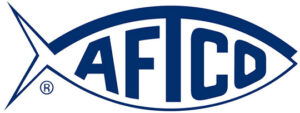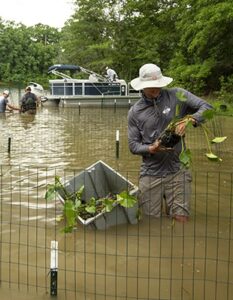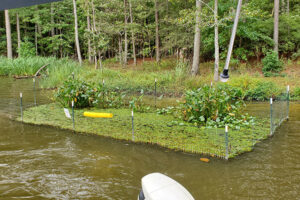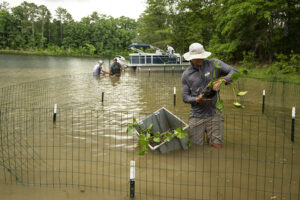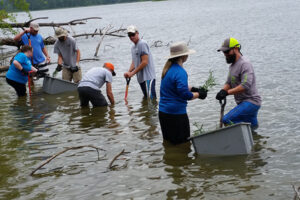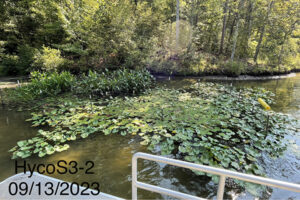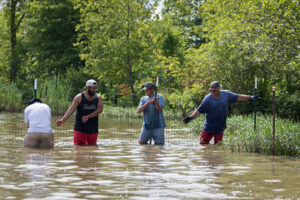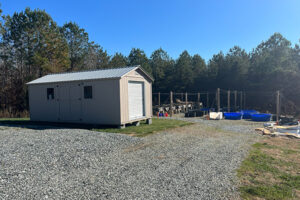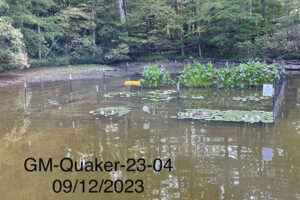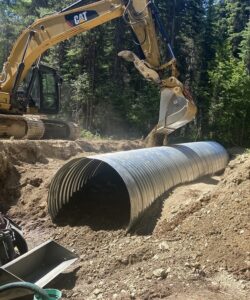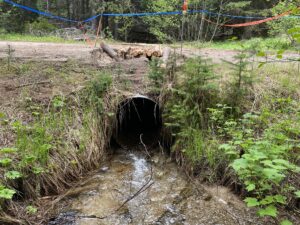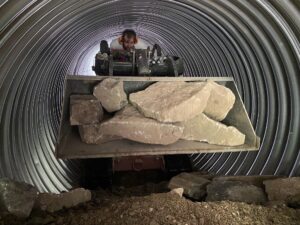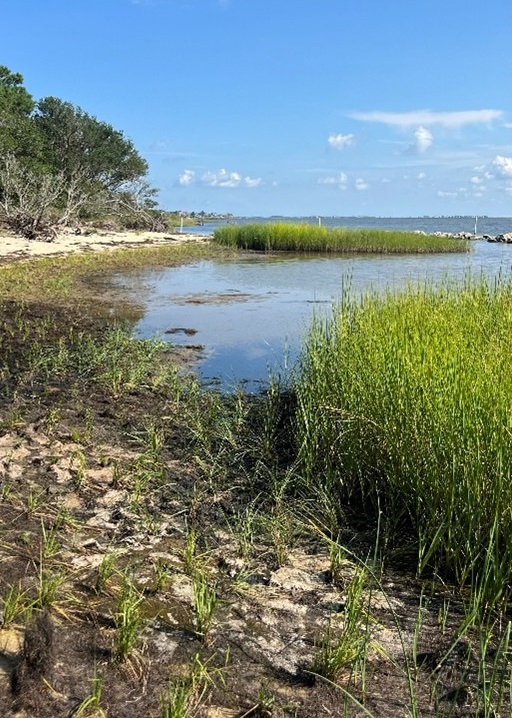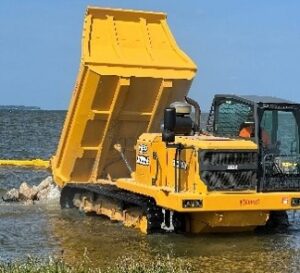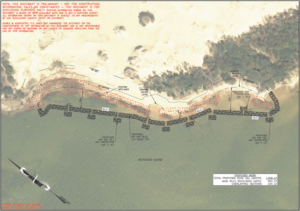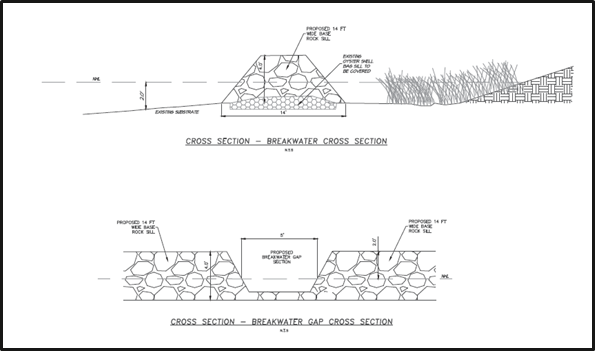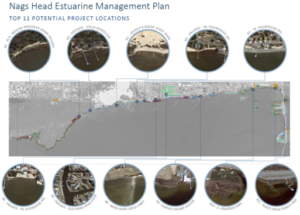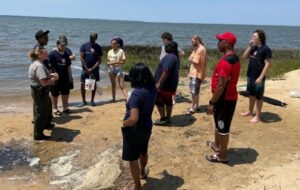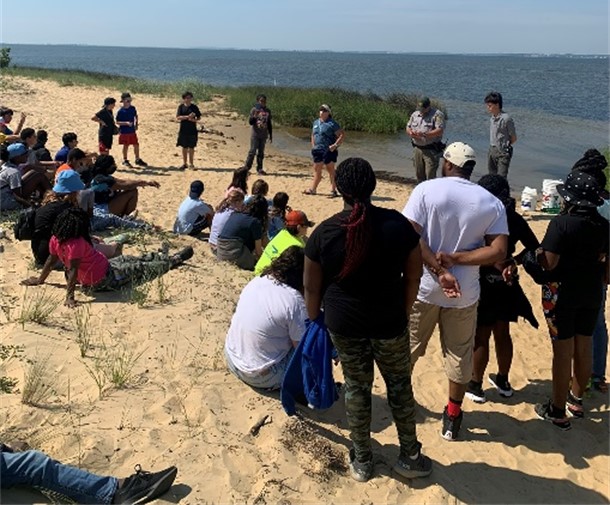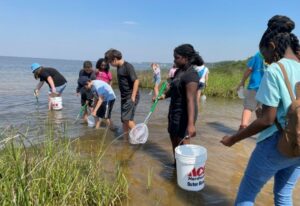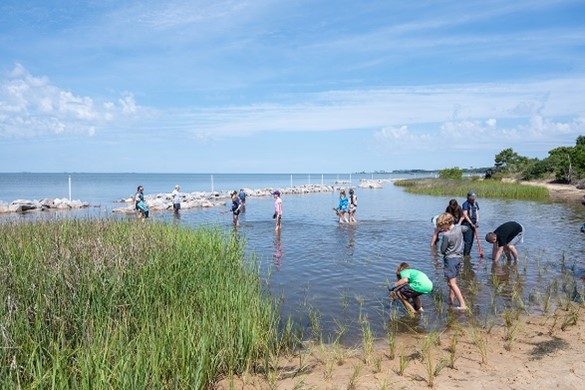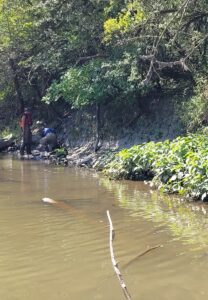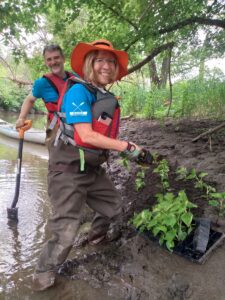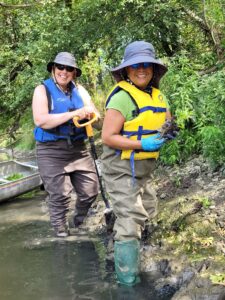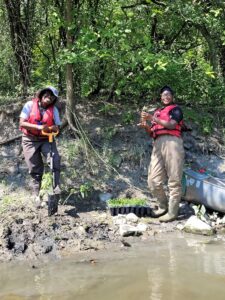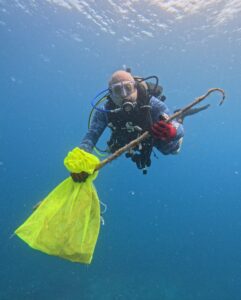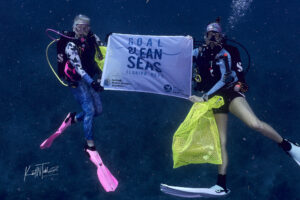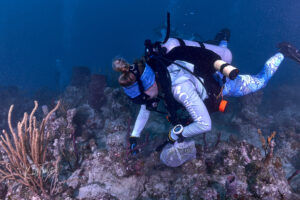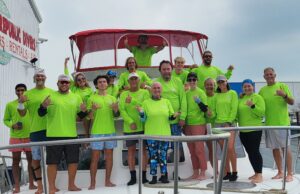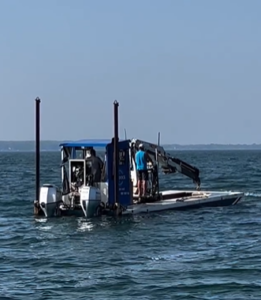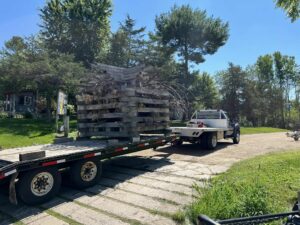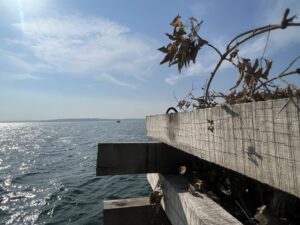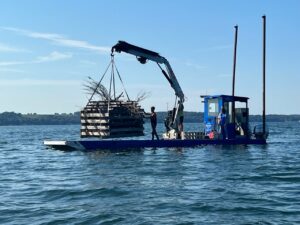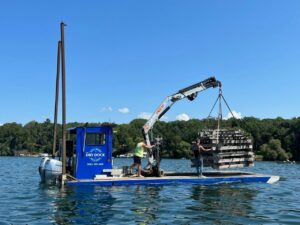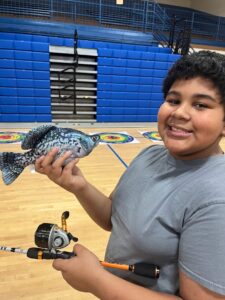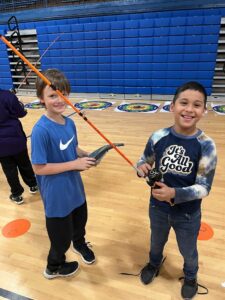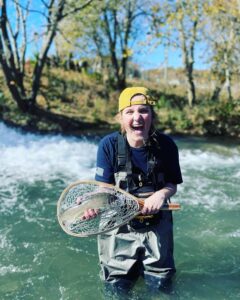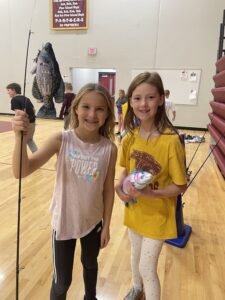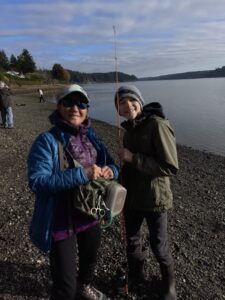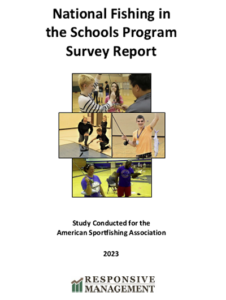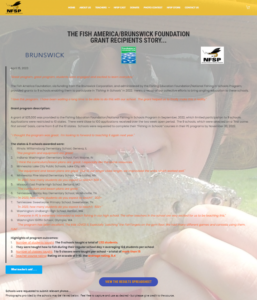Projects – 2023
With the generous support of AFTCO, the following conservation project was funded for 2023.
The FishAmerica Foundation is grateful for the generous support of AFTCO. This was the first project funded by AFTCO and we look forward to future projects together.
Learn about the projects funded in 2022.
North Carolina Aquatic Plant Nursery
The North Carolina Wildlife Resources Commission (Commission) was awarded $25,000 to help in constructing their aquatic plant nursery. In 2014, the Commission decided to make establishing native aquatic vegetation in reservoirs a priority. Since that time, the Commission has planted over 20,000 plants in 11 waterbodies across North Carolina. The primary goal of these projects is to establish self-sustaining and expanding native plant communities in reservoirs that can provide habitat for juvenile and adult fish, improve water quality and clarity, reduce rates of shoreline erosion and sediment resuspension, and providing competition with invasive plant and algal species as well as establishing plants communities that can withstand climate change. Initial revegetation eorts used plants transplanted from local waterbodies, purchased from commercial vendors, and/or grown in an unused fish hatchery raceway. The construction of a larger facility will increase plant production capability as well as provide a better capability to overwinter plants and create sustainable on-sites sources of material. The capacity of the nursery will expand over time from 4,000 plants in 2022 to 6,000 plants in 2023 to 12,000 plants by 2024.
With the generous support of Grizzly, the following conservation projects were funded for 2023.
The FishAmerica Foundation has partnered with American Snuff Co. and their Grizzly brand since 2014. Their donations have contributed to programs that build essential reef habitat, that develop fisheries management and access plans, and prevent the littering of our waterways.
Learn about the projects funded in 2022.
Granite Creek, Missoula, Montana
The Clark Fork Coalition of Missoula, Montana, was awarded a grant for improving road crossings on eight sites of Granite Creek, a coldwater tributary to the Lolo River. The purpose of this project is to increase the habitat for native fish populations including Bull Trout, Westslope Cutthroat Trout and other salmonid species. In 2009, the National Forest acquired more than 32 square miles of timber lands in Upper Lolo Creek watershed as part of the larger ‘Montana Legacy Project’ in Western Montana. This land acquisition provides an opportunity for restoration and enhancement opportunities in the basin. Working with the U.S. Forest Service, the Clark Fork Coalition improved fish passage in tributaries of Granite Creek and reduced chronic stream sedimentation. Specifically, eight road crossings along Granite Creek road (FS 9942) that impeded fish migration and contributed to higher sediment loads in the creek were replaced with larger culverts integrated with the streambed and allowing passage of fish into critical spawning and rearing habitat. Since 2006, road decommissioning and other road treatments have reduced overall sediment inputs and hydrologic impacts at a large scale in the Lolo Creek headwaters by removing stream crossings replacing culverts, culverts and installing dozens of large wood jams. The entire project area lies on accessible public land and is open to angling. Wild fish populations are expected to increase because of the project, leading to more opportunity for angling success. This project is a collaborative project with the Clark Fork Coalition, the Missoula District of the Lolo National Forest, Montana Department of Environmental Quality and Montana Fish Wildlife and Parks.
Jockey’s Ridge, North Carolina
The North Carolina Coastal Federation was awarded $73,860 to protect and restore a 725-foot section of the estuarine shoreline on Roanoke Sound, North Carolina, that is resulting in loss of fish habitat and degradation of water quality. This project installed an adaptive management strategy to stabilize the eroding shoreline, provide coastal habitat and protect water quality, educate and engage the public, and provide safe access for over 1.9 million visitors to this public resource. This stretch of shoreline is exposed to high wave energy as well as erosion from foot traffic from the adjacent popular sound-side walking trail. Pre-project monitoring of the site showed greater fish diversity at the adjacent wetland fringe site as compared to the estuarine beach site, with eight of the ten most commercially or recreationally important species found at the wetland site (including Red Drum, Sheepshead, Striped Mullet, Blue Crab, Atlantic Croaker, Southern Sea Mullet, and Spot). Working in conjunction with Jockey Ridge State Park and other partners, this group installed a durable granite cap on the existing oyster sill to achieve a fixed height that is not dependent on oyster colonization. This will provide consistent sill height, shoreline stabilization, and new wetland habitat through additional community plantings of aquatic vegetation. The project engaged over 100 local students and volunteers
The following conservation projects were funded with the generous support of the Brunswick Foundation.
The FishAmerica Foundation has partnered with the Brunswick Foundation. Their donations have contributed to programs that build essential reef habitat, that develop fisheries management and access plans, and prevent the littering of our waterways.
Learn about the projects funded in 2022.
Chicago-Calumet River
The Friends of the Chicago River was awarded $9,527 for their Fish Habitat Planting Expansion Project involving the installation of native water willow and lizard’s tail to improve fish habitat in the Chicago-Calumet River system. The history of this system was one of pollution, degradation, and neglect that closed off the river from people and wildlife. Through collaborative efforts during the past several decades, the river system is finally taking its place as one of the world’s greatest metropolitan rivers, thriving with activity and wildlife. Most notably, an increase of fish species in the river from seven to more than 75 since the 1970s (including 18 new native species since 2001) demonstrates the in-stream impacts that have occurred. However, a lack of habitat in the river remains, which has been identified as a major feature in limiting fish productivity in studies completed by the Illinois Department of Natural Resources (IDNR). A 2019 assessment found that 75% of the river’s banks are still natural despite an abundance of seawalls and the perception that more of the river-edge is lined with steel or concrete. These natural banks present an opportunity to improve habitat through the introduction of multi-beneficial native plants. Plantings are self-sustaining and will expand via rhizome. IDNR has had success with water willow and lizard’s tail in the past, where vast stands have grown providing valuable habitat for native fish species and other aquatic life. The actual outcomes for this project were:
- Installing 1,440 native plants to benefit fish habitat and water quality
- Restoring at least 1,440 linear feet of the Chicago-Calumet River system within an environmental justice community
- Recruiting 78 volunteers to implement the work
- Empowering 352 hours of community environmental stewardship
In the long term, as the native plant colonies grow and expand, these improvements to the river will lead to better water quality and habitat for native fish. FishAmerica funds provided travel to project sites, supplies (purchase of water willow and lizard’s tail, but also miscellaneous, lunches and water for volunteers and limited program staff support.
Florida Keys National Marine Sanctuary
The National Marine Sanctuary Foundation is was awarded $18,114 for marine debris cleanup in the Florida Keys National Marine Sanctuary (NMS). A review of all marine debris found, removed and reported in 2018-2022 showed that the top ten debris items affecting the Florida Keys Reef Tract are (1) fishing line/monofilament, (2) cloth rope from anchors and traps, (3) fishing sinkers, lures, and hooks, (4) wood lobster trap fragments, (5) plastic and nylon rope (lobster and crab traps), (6) fishing traps and pots, (7) fishing rods and poles, (8) glass beverage bottles, (9) aluminum cans, and (10) wire mesh and metal trap fragments. The persistent marine debris problem in the Florida Keys is also further worsened by increased storm activity. To combat this, the “Goal: Clean Seas Florida Keys” initiative was developed through the National Marine Sanctuary. The Florida Keys NMS trains SCUBA diving operators on environmental best practices and engages divers to remove marine debris from sensitive areas, especially coral reefs. Dive operators apply through a competitive request-for-proposals process to receive funding from the Foundation to engage and oversee volunteer divers in marine debris removal. FishAmerica funds supported 24 cleanup dives covering 76,000 square meters of seafloor where 1,456 pounds of derelict fishing traps, anchors, monofilament and other marine debris were successfully removed. Participating dive operators educated and engaged 349 individuals.
Green Lake Aquatic Structure
The Green Lake Sanitary District (GLSD) was awarded $15,000 for a fish structure project in Green Lake, Wisconsin. This is a 7,920-acre lake that has a maximum depth of 236 feet. Visitors have access to the lake from public boat landings and public beaches. Popular fisheries include Panfish, Largemouth Bass, Smallmouth Bass, Northern Pike, Trout, Walleye and Catfish. The Lake Management Plan states that the loss of near shore vegetation and coarse woody debris has detrimentally impacted fish populations. The Plan indicates that habitat protection and restoration are key to help improve fish population numbers to reach their full potential. The addition of complex woody habitat consisting of 8-10 “fish condos” and 25-30 fish cribs will increase fish habitat as a partial means to address this problem and be used in providing educational opportunities about habitat importance for the youth and general public.
Fishing in Schools
The Fishing Education Foundation was awarded $25,000 to support implementation of the National Fishing in Schools Program (NFSP) in 9 schools. NFSP provides two all-inclusive standards-based fishing programs, both fly fishing and spin casting, that provide all the tools a school needs to implement an effective fishing program into their daily PE curriculum. Schools receiving grant awards are required to participate in NFSP for a minimum of 3 years. The objective is for each school to provide on the water fishing experiences for students. If desired, a condition of grant award could be the requirement for the school to agree to conduct such an event. NFSP calls these events, “F.I.S.H. Event” (Fishing in Schools Happening.) The awarded schools taught a total of 1,112 students. A survey evaluates all participating students before and after their participation in the program to find results as to a student’s participation in the sport before and after the program if they purchase equipment and their intent to participate in the sport in the future.

